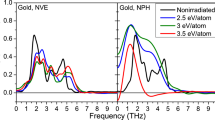Abstract
High purity Pt, Ni, Cu, Fe and Al metal foils were electroplated with carrier-free111In probe atoms and melted at 293 K using 32 ns ruby laser pulses with energy densities in the range 1–10 J cm−2. Three distinct lattice locations of the probe atoms were detected in the melted surface layers using perturbed γ-γ angular correlation spectroscopy: (i) defect-free substitutional sites, (ii) non-unique sites with broad distributions of quadrupole interactions, and (iii) a probemonovacancy complex (for Pt only). The defect-free fraction was found to approach 100% when Pt is irradiated at 9 J cm−2. The fraction of probes on defect-free sites was found to increase with the energy density of the pulse and with the solubility of In in the metals. The data are consistent with the idea that laser surface-melting produces high concentrations of vacancies and lattice sinks, although no thermal trapping of point defects was detected.
Similar content being viewed by others
References
See, e.g., P.S. Peercy, inLaser Surface Treatment of Metals, ed. C.W. Draper and P. Mazzoldi, Nato ASI Series E: Applied Sciences, vo. 15 (Martinus Nijhoff, Dordrecht, 1986) p. 57
J. Narayan, inLaser and Electron-Beam Interactions with Solids, ed. B.R. Appleton and G.J. Celler (North-Holland, Amsterdam, 1982) p. 389.
W.R. Wampler, D.M. Follstacdt and P.S. Peercy, inNuclear and Electron Resonance Spectroscopies Applied to Materials Science, eds. E.N. Kaufmann and G.K. Shenoy (Elsevier North-Holland, New York, 1981) p. 567.
S.T. Picraux and D.M. Follstaedt, inSurface Modification and Alloying by Laser, Ion and Electron Beams, eds. J.M. Poate, G. Foti and D.C. Jacobson, Nato Conference Series VI: Materials Science, vol. 8 (Plenum, New York, 1983) p. 287.
L. Buene, E.N. Kaufmann, M.L. McDonald, J. Kothaus, R. Vianden, K. Freitag and C.W. Draper, in ref.4, p. 391; E.N. Kaufmann, L. Buene, M.L. McDonald, J. Kothaus, K. Freitag, R. Vianden and C.W. Draper, Nucl. Inst. Meth. 209/210 (1983)427.
F. Pleiter and K. Prasad, Hyperfine Interactions 20(1984)221; F. Pleiter and K. Prasad, Phys. Lett. 84A(1981)345.
G.S. Collins, C. Allard, C. Hohenemser and C.W. Draper, Mater. Res. Soc. Symp. Proc. 82(1987)53.
F. Pleiter and C. Hohenemser, Phys. Rev. B25(1982)106.
A.R. Arends, C. Hohenemser, F. Pleiter, H. de Waard, L. Chow and R.M. Suter, Hyperfine Interactions 3(1977)87.
W. Bolse, M. Uhrmacher and K.P. Lieb, Phys. Rev. B36(1987)1818.
G.S. Collins and R.B. Schuhmann, Hyperfine Interactions 15/16(1983)395.
Author information
Authors and Affiliations
Additional information
Supported in part by National Science Foundation grant DMR 86-19688 (Metallurgy Program).
Rights and permissions
About this article
Cite this article
Collins, G.S., Zainun, K. Laser surface-melting of metals studied by PAC. Hyperfine Interact 61, 1339–1342 (1990). https://doi.org/10.1007/BF02407620
Issue Date:
DOI: https://doi.org/10.1007/BF02407620




